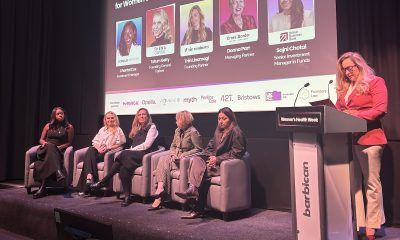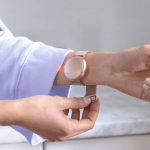Entrepreneur
Europe’s first tissue bank for women launches in Liverpool

Europe’s first private, women’s health tissue bank has been launched by Liverpool-based laboratory and medical education provider BioGrad, backed by a £25m investment.
The new tissue bank will work to investigate treatments and cures for women’s health conditions such as menopause, endometriosis, cancers, and polycystic ovarian syndrome (PCOS), according to reports.
The bank aims to accelerate stem cell and immunotherapy research, potentially driving “groundbreaking” discoveries.
Based in Wavertree Technology Park, Liverpool, the BioGrad Research Tissue Bank has ethical approval to recruit donors and create libraries of samples, according to Dr Natalie Kenny, CEO of BioGrad Group. Samples can be donated anonymously to the bank, which will be made available for university researchers and NHS trusts across the UK.
The company is now building an app alongside the tissue bank to enable donors to see how their samples are used.
“This makes research cheaper and much easier to conduct, which in turn makes diagnostic tests and treatments faster and cheaper to develop,” Kenny said.
“One of the biggest barriers to women’s health research is the lack of biobanks with women’s samples and ethical approval for utilising these samples outside of the narrow confines of the original study.
“We are already working with NHS trusts to collect samples for research, however the real focus of the bank is improving women’s health, collecting samples to improve research on conditions such as endometriosis, menopause and pregnancy loss.”
BioGrad will soon be calling on women across the country to donate samples for research, including menstrual blood, umbilical bord blood and tissue, peripheral blood, urine, saliva, nose and throat swabs, vaginal swabs, rectal or stoma swabs and breast milk.
Donors will be reimbursed for their contributions, and will be able to collect samples using BioGrad’s at-home collection kits or at the BioGrad clinic.
“Not only will this act as a rich resource in the Liverpool City Region, it will also provide additional skilled jobs in the Wavertree area,” Kenny said.
News
Ending the guesswork in cancer care: A CEO’s vision for predictive precision oncology

By Wolfgang Hackl M.D., Founder & CEO, OncoGenomX Inc., Switzerland
During my career as an oncologist and cancer drug developer, one question haunted me more than any other: Why do some patients respond to therapy — while others, with the same diagnosis, do not?
We have innovative treatments, biomarkers, advanced lab tests, and guidelines. But far too often, despite all that science, our treatment decisions come down to educated guesswork.
As medicine evolves, so do our data — but not always our ability to act on it with precision.
That enduring gap between what we know and what we can predict inspired me to found OncoGenomX, and to build PredictionStar™, a platform designed to redefine what precision oncology truly means.
From Biomarkers to Behavior: The Missing Link
Today, most molecular cancer tests focus on eligibility: they tell us whether a tumour expresses a particular target or carries a known mutation. This is useful, but it’s only half the story.

Eligibility does not equal efficacy.
Knowing that a patient’s tumour expresses the estrogen receptor (ER), or harbours a PIK3CA mutation, doesn’t mean it will respond to hormone therapy or PI3K inhibition. It simply means those drugs might work. And in oncology, “might” is not enough.
PredictionStar™ was built to close this precision gap — by answering not just which drugs can be used, but which will actually work.
We call this Precision Drug–Tumor Matching: the ability to segregate effective from ineffective treatments by connecting genomic and phenotypic insights into a coherent tumour profile predictive of therapeutic response.
Introducing PredictionStar™: Coherent Biomarker Intelligence
PredictionStar™ is a multidimensional tumour profiling and decision-support system powered by what we term Generative Clinical Intelligence™ — the synthesis of high-quality sequencing data and AI-driven interpretation into clear, actionable clinical guidance.
 Traditional assays analyse biomarkers in isolation, treating each gene mutation or expression pattern as a separate clue.
Traditional assays analyse biomarkers in isolation, treating each gene mutation or expression pattern as a separate clue.
PredictionStar™ instead identifies logically connected biomarker constellations — genomic enablers that reveal which response mechanisms are active, and phenotypic differentiators how likely the tumour will respond.
This networked approach replaces fragmented snapshots with an integrated, functional map of tumour behaviour.
It provides oncologists with something they rarely get from today’s tests: confidence. In clinical modelling, PredictionStar™ has the potential to reduce overtreatment fivefold and lower the cost of achieving one year of tumour growth control by 35 per cent.
But the numbers tell only part of the story. Behind them are patients spared from unnecessary toxicity — and doctors empowered to treat with precision instead of probability.
Built on the Technology of Giants
PredictionStar™ was designed for seamless integration into modern real-world workflows, harmonized and cross-validated to ensure reliability, and reproducibility.

The platform’s pre-sequencing tumor workup is fully standardised, minimizing inter-laboratory variability that can otherwise reach 70 per cent.
From tumour processing to data interpretation, PredictionStar™ enforces the same rigorous quality in every step, producing consistent and concordant results across labs.
As far as cloud architecture optimized for medical data privacy and global scalability we are privileged to work with world class-players of the health IOT industry
(F. Gaede, Oct 2025, Nordcloud).
A Femtech Focus: Personalising Breast Cancer Therapy
While PredictionStar™ has broad oncology applications, our first focus is hormone receptor-positive breast cancer, the most prevalent form among women.
It is here that the limits of current diagnostics are most evident — and the need for predictive and prescriptive clarity is greatest.
 Even within hormone-dependent breast cancer, the most favorable form of the disease, patient outcomes vary widely. Some women respond beautifully to endocrine therapy for years, while others progress rapidly.
Even within hormone-dependent breast cancer, the most favorable form of the disease, patient outcomes vary widely. Some women respond beautifully to endocrine therapy for years, while others progress rapidly.
What makes the difference? The answers are buried in the tumour’s individual response profiles — but until now, we lacked the tools to decode them. PredictionStar™ offers that decoding ability.
Our non-interventional validation study, conducted in collaboration with clinical researchers from the Veterans Affairs Medical Centers in Cincinnati, Los Angeles, and Miami, involves data from over 4,300 patients with hormone receptor-positive disease.
By correlating predicted responses with actual treatment outcomes, we aim to establish a new clinical standard for predictive accuracy.
Our roadmap includes RUO and LDT certification in 2026, FDA-IDE clearance in Q2 2027, first RUO test sales as early as Q1 2027, and clinical study use from Q3 2027 onwards.
Redefining Precision Oncology
To understand why this matters, we need to reframe what “precision” means.
Most tests today are prognostic or eligibility-based. They classify risk or confirm target presence. PredictionStar™ adds a third, transformative dimension: functional prediction. It asks, “Which therapies will this specific tumour respond to — and how strongly?”
This evolution turns diagnostics into a true decision-support tool, enabling oncologists to design treatment compositions optimized for efficacy, rather than constrained by averages.
The distinction may seem subtle, but its impact for individuals living with breast cancer is enormous: Prognostic and eligibility tests describe. PredictionStar™ guides.
Innovation Through Unity
Our strength lies in collaboration.
I’ve often said that OncoGenomX stands “on the technology of giants, powered by the ambition to transform.” That is more than a slogan — it’s our reality. We built PredictionStar™ not as an isolated product, but as a platform for partnership.
Its architecture invites integration — with hospital systems, sequencing providers, AI developers, and pharmaceutical R&D pipelines.
In the coming years, we envision PredictionStar™ evolving into a broader family of tools: PredictionStar DX™ for predictive diagnostics, PredictionStar GCI™ for data integration and generation of actionable clinical intelligence, and PredictionStar IOT™ for real-time connectivity. Each module serves the same purpose: to transform complexity into clarity.
From Data to Decisions: A Personal Reflection
At its heart, PredictionStar™ was born from empathy.
As a clinician, I saw too many patients fall through the cracks — not because we lacked treatments, but because we lacked foresight.
Data without interpretation is noise. Our mission is to turn that noise into understanding.
When I speak with oncologists today, I sense both excitement and relief: “We will no longer be limited to maybes.” “We can begin to quantify response likelihood, combine therapies more rationally, and give patients something we cannot give today: certainty”.
Technology can be transformative, but only when anchored in purpose. For OncoGenomX, that purpose is simple — to give every patient the best possible chance at lasting response.
The Road Ahead
Our journey is just beginning. We are validating, scaling, and expanding across cancer types — from breast to prostate, lung, and beyond.
But our guiding principle remains unchanged: wherever there is cancer, there is a need for precision drug–tumour matching.
The convergence of genomics, phenomics, AI, and clinical data is redefining healthcare.
PredictionStar™ is part of that transformation — proving that predictive precision is not a futuristic concept, but an attainable standard.
We owe it to patients, to clinicians, and to science itself to make that standard universal.
In Closing
When I founded OncoGenomX, I imagined a world where no cancer patient has to live with uncertainty — where treatment is guided by prediction, not probability.
Today, that world feels within reach. PredictionStar™ is more than technology. It’s a promise:
That every patient deserves clarity. That every tumour can be understood.
And that, together, we can end the guesswork in cancer care.
Contact: Dr. Wolfgang Hackl | Founder & CEO, OncoGenomX | E-Mail | LinkedIn WH | Company Webpage | LinkedIn OGX
Entrepreneur
From SEO to GEO: How women’s health brands can get found in the age of AI

By Martin Piria, senior machine learning engineer at Ema
Search has changed.
For years, Women’s Health companies have invested in SEO, optimising their websites so Google would surface their content.
But now, as consumers increasingly ask health questions directly to AI like ChatGPT, Perplexity, Ema, or Claude, a new frontier is emerging for brands that want to market their women’s health product or service: Generative Engine Optimization (GEO).
Here’s how women’s health brands should think about GEO today.
GEO ≠ SEO — But They Overlap
Think of it like this:
- Google vs Bing: Searching on Bing doesn’t influence what you see on Google.
- LLMs vs Search: Similarly, what OpenAI scrapes to train its models isn’t connected to how Anthropic’s model is built. Each AI has its own training architecture and knowledge base.
SEO remains critical because most grounding searches still pull from Google.
But GEO adds a new layer: how your content is scraped, stored, and tokenized by large language models.
What LLMs “Love”
LLMs aren’t people. They’re statistical machines predicting the next token. To show up inside them, your content needs to be:
- LLM-friendly HTML: Clean, semantic code that models can parse.
- Fact highlights: Clear, authoritative statements that models can confidently repeat.
- Structured links & references: High-authority citations that reinforce your credibility.
- Accessible APIs: Easy integrations for platforms like Bing, Perplexity, or Google’s SGE.
You need to learn which tokens trigger what generations in the LLM.
Tokens that the model has well-modeled won’t go to the web. You want tokens where the model has low confidence, and you want to be the first hit when it grounds the answer.
How to Spot “Weak Tokens”
Weak tokens are concepts or queries where the model has low confidence and goes searching the web for reinforcement. That’s your opportunity.
If your Women’s Health company creates the most authoritative, well-structured page on that concept, you become the go-to reference.
Pro tip: Ask ChatGPT (or another LLM) to generate an answer in your space, then look for where it hesitates, says “I don’t know,” or provides shallow coverage.
Those are your GEO goldmines.
Action Steps for Women’s Health Brands
- Keep building SEO: Traditional search still drives discovery and traffic.
- Audit your content for LLM-friendliness: Is your HTML semantic? Are facts highlighted clearly? Do you have structured data?
- Target underserved queries: Use AI tools to test what’s missing from LLM answers in your domain.
- Be the first grounding result: For low-confidence tokens, make sure you’re the top hit on Bing, Perplexity, and Google.
- Think prevention-first: Just as we design Ema to prioritize safety and clarity, your content should be structured, factual, and easy to cite.
Resources to Go Deeper
- GPT-3 Linguistics 101 (Medium) — a great breakdown of how tokens and vocabularies work in LLMs.
- Research from AI marketing leaders on Generative Engine Optimization (GEO).
- Technical guides on schema markup and structured data for SEO, which often doubles as LLM-friendly content.
The Bottom Line for Women’s Health
- Clarity + authority = visibility. The more accessible and trustworthy your content, the more likely LLMs will surface it.
- Your opportunity: Make your Women’s Health brand the voice that AI turns to when women ask critical questions. SEO found you on Google. GEO will get you found inside the conversations that matter next.
Find out more about Ema at emaapp.co
News
Propel Healthtech West Yorkshire launches programme to support healthtech innovators

Propel Healthtech West Yorkshire is calling on innovators with healthtech solutions to apply for its accelerator programme.
The programme is free for successful applicants and provides enhanced business support, regulatory guidance, NHS networking and scaled growth advice.
The accelerator has recently been allocated £4.5m in funding from the West Yorkshire Mayor’s investment Zone.
The funding is part of the region’s £160m Investment Zone to support the growth of the health innovation and technology sector.
The funding granted to Propel Healthtech will enable it to expand and support more innovators.
Tracy Brabin, Mayor of West Yorkshire, said: “The first priority of our Local Growth Plan is to boost our region’s fastest growing business sectors, because we know that’s how we’re going to drive investment, create jobs and put more money in people’s pockets.
“Today, we’re launching £4.5 million of new support for our world-leading health technology firms, which already generate £3 billion for our economy but could go even further with the right backing.
“This will help with access to finance, skills and workspace to bolster collaboration with hospitals and universities, boosting growth and helping us build a stronger, brighter West Yorkshire.”
Over the next four years the scheme will support hundreds of businesses helping them to scale in the NHS, contribute to regional economic growth and develop life-changing innovations for patients.
Propel Healthtech is supported by a host of national and international business partners with lived experience of operating in the global marketplace and will support businesses from early-stage through to scaling into worldwide markets.
It is open to early-stage innovators and scale-up organisations (those that already have traction in the NHS and want to scale further), that can demonstrate innovative solutions that can be used by the NHS.
All applicants should have an existing presence in the region or be willing to establish one.
Successful organisations will receive a bespoke support package based on their businesses’ needs.
Depending on whether the company is a startup or a scaleup, the six-month programme provides innovators a series of masterclasses, innovator surgeries, events and 1-2-1 mentoring sessions.
All innovators will also have access to Propel HealthTech partners who bring specific expertise to the programme as well as the West Yorkshire ecosystem partners.
The accelerator aims to encourage a diverse range of applications, particularly from female founders, innovators from BAME communities and entrepreneurs with a disability.
Michael Morgan-Curran, CEO of Asclepius MedTech and one of last year’s cohort said: “The Propel accelerator exceeded our expectations.
“It has helped us build and develop deeper and more meaningful relationships with hospital trusts and introduced us to important ecosystem partners.
“The rigour of the programme modules and workshops crystallised our value proposition and helped us understand how to navigate the NHS healthcare systems, and better appreciate their needs, priorities, processes and challenges.
“The response we have had has been amazing and it continues as Propel Alumni. None of this would have happened if we hadn’t been in the programme”
Apply for Propel HealthTech West Yorkshire
Healthtech solutions could be medical devices, diagnostics, including In-Vitro Diagnostics (IVD), digital health, including data driven health technologies and artificial intelligence (AI) and other health technology innovations that can be shown to be in scope
Health Innovation Yorkshire & Humber established the Propel HealthTech programme in 2018 to support healthtech SMEs with innovative solutions destined for the NHS.
Over the last six years the accelerator has supported 125 innovators, both from the UK and international waters, created 143 jobs, with £940k invested into the local economy and £37.m investment raised by the companies.
Applications are open until 4pm, Friday 7 November

 News2 weeks ago
News2 weeks agoDozens of women report suffering painful burns after using Always sanitary towels

 News4 weeks ago
News4 weeks agoFDA plans to revise black box warning on menopause hormone therapies

 News2 weeks ago
News2 weeks agoWomen’s health innovations recognised in TIME’s Best Inventions 2025

 News3 weeks ago
News3 weeks agoAI-powered women’s health companion Nexus launches in UK

 News4 weeks ago
News4 weeks agoScientists turn human skin cells into eggs in IVF breakthrough

 Events2 weeks ago
Events2 weeks agoCutting through the noise in femtech – key takeaways from Women’s Health Week 2025

 News3 weeks ago
News3 weeks agoMenstrual cycle affects women’s reaction time, study finds

 Menopause4 weeks ago
Menopause4 weeks agoDaily pill could delay menopause ‘by years,’ study finds

























